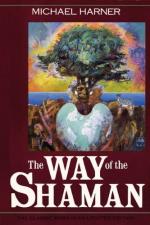
|
| Name: _________________________ | Period: ___________________ |
This test consists of 5 multiple choice questions, 5 short answer questions, and 10 short essay questions.
Multiple Choice Questions
1. How do the Conibo access the Lowerworld?
(a) Riding on the backs of patagonian capybaras.
(b) Through secret holes dug by their ancestors.
(c) By chanting and dancing all night in front of a fire.
(d) Using a giant catahua tree root system.
2. Included in the reports from participants of Harner's first guided shamanic exercise are:
(a) Numerous cases of people experiencing nausea and vertigo.
(b) Suggestions on what to do when encountering an impenetrable obstacle.
(c) Accounts of disappearing momentarily and not being seen by others in the room.
(d) Detailed conversations with star people and other extraterrestrials.
3. A shaman might enter a shamanic state of consciousness to bring back messages for whom?
(a) Doctors treating a patient.
(b) A patient in ordinary reality.
(c) A patient's loved ones.
(d) Non-traditional doctors in ordinary reality.
4. After a journey that lasts several days in the jungle with his companions, Harner is taken where?
(a) To a ledge overlooking an enchanted valley.
(b) To the source of the Amazon to meet the highest shaman.
(c) Beneath a waterfall for a mystical experience.
(d) On another journey to experience higher levels of reality.
5. How does a shaman typically travel into the Lowerworld?
(a) Through a hole or tunnel.
(b) By teleporting.
(c) Wearing a special cloak.
(d) On the wings of a dragon.
Short Answer Questions
1. At the conclusion of the rock-seeing process, after the shaman turns the stones around and examines all sides, what does the shaman do?
2. Apprentice shamans sometimes report to Harner that they:
3. How might a shaman be distinguished from other medicine men?
4. When the shaman is in an altered state, how does healing take place?
5. Who does the author quote as an expert on the subject of altered states?
Short Essay Questions
1. What is the practice of rock-seeing?
2. Explain the connection between an individual and his or her guardian spirit.
3. Describe an environment that's conducive to the shaman being most effective while in a shamanic state of consciousness (SSC).
4. Describe Harner's journey with Akachu.
5. Describe the tunnel a shaman utilizes to journey into the Lowerworld.
6. What are the main functions and activities of a shaman, as described in Chapter 3?
7. How does a shaman take care of his or her tsentak?
8. What is the participant of the exercise in Chapter 2 instructed regarding the end of the journey?
9. What are some of the similarities Harner notes in first-hand shamanic experiences reported by middle-class Americans?
10. What does a shaman do with the tsentak to help a patient?
|
This section contains 1,029 words (approx. 4 pages at 300 words per page) |

|




